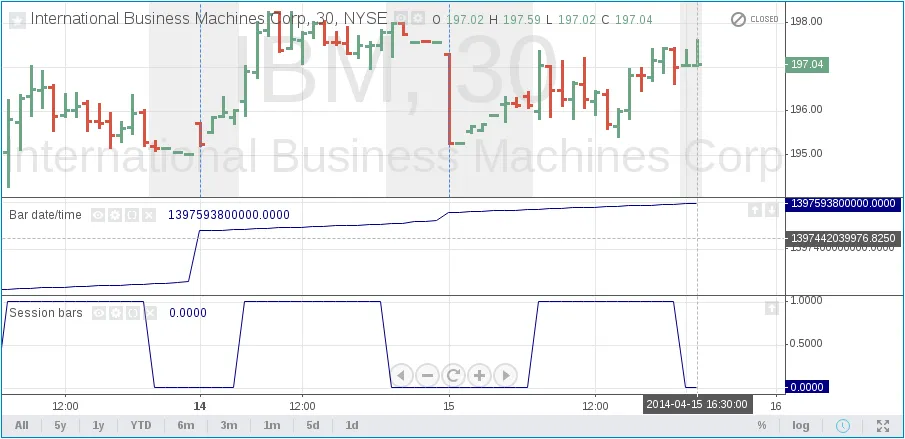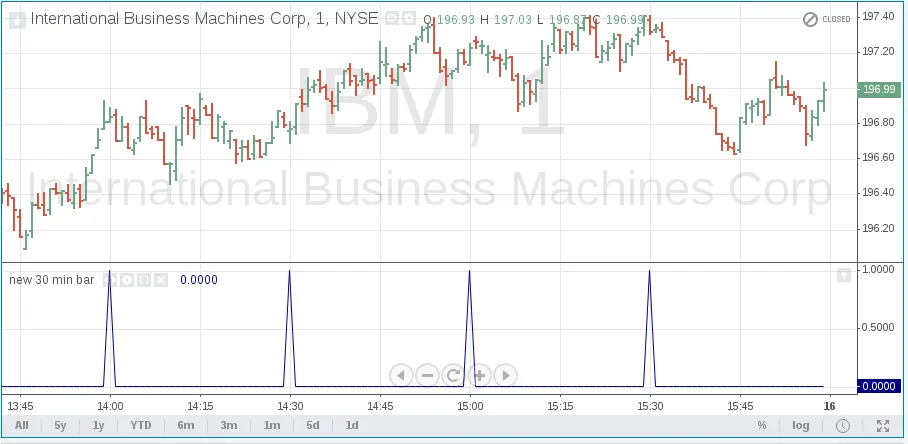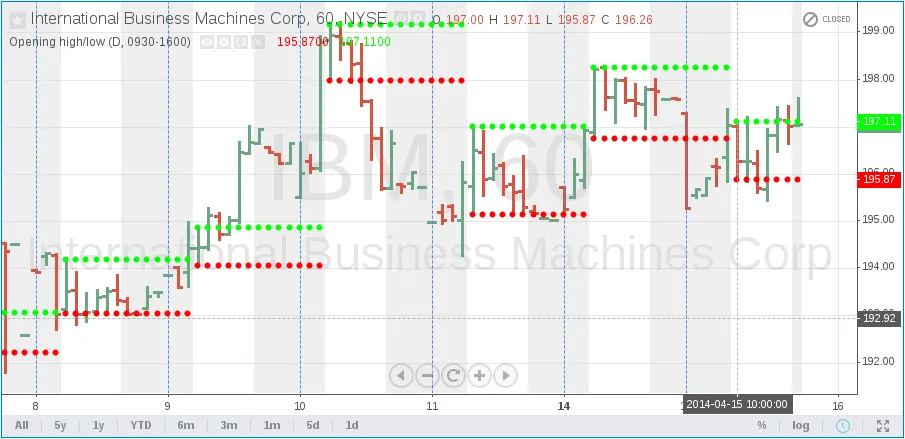Sessions and time functions
Functions and the variable time
In Pine there are special means for working with trade sessions, time and date. We will review a simple chart, IBM,30 on which has been applied 2 scripts: “Bar date/time” and “Session bars”.

Here is the initial code of the first script “Bar date/time”:
This illustrates the meaning of the variable time. The variable
time
returns the date/time (timestamp) of each bar start on the chart in
UNIX format1. As can be
seen from the screenshot, the value time on the last bar is equal to
1397593800000. This value is the number of milliseconds that have
passed since 00:00:00 UTC, 1 January, 1970 and corresponds to Tuesday,
15th of April, 2014 at 20:30:00 UTC. The chart’s time gauge in the
screenshot shows the time of the last bar as 2014-04-15 16:30 (in the
exchange timezone, from here the difference between this time and UTC is
4 hours).
The second script, “Session bars”:
This shows how the user can distinguish between session bars and bars
that get into extended hours by using the built-in function time and
not the variable time (the background behind these bars has been
colored over with grey). The function time returns the time of the bar
start in milliseconds UNIX time or na value if the bar is located
outside the given trade session (09:30-16:00 in our example). time
accepts two arguments, the first is resolution, the bars of which are
needed to determine their timestamp, and the second — session
(session specification), which is a string that specifies the beginning
and end of the trade session (in the exchange timezone). The string
“0930-1600” corresponds to the trade session of IBM symbol. Examples
of trade session specifications:
“0000-0000”
a complete 24 hours with the session beginning at midnight.
“1700-1700”
a complete 24 hours with the session beginning at 17:00.
“0900-1600,1700-2000”
a session that begins at 9:00 with a break at 16:00 until 17:00 and ending at 20:00.
“2000-1630”
an overnight session that begins at 20:00 and ends at 16:30 the next day.
“0930-1700:146”
a session that begins at 9:30 and ends at 17:00 on Sundays (1), Wednesdays (4) and Fridays (6) (other days of the week are days off).
“24x7”
is everyday session 00:00—00:00.
“0000-0000:1234567”
same as “24x7”, an everyday session 00:00—00:00.
“0000-0000:23456”
same as “0000-0000”, Monday to Friday session that starts every day at 00:00 and ends at 00:00 of the next day.
“1700-1700”
is an overnight session. Monday session starts at Sunday, 17:00, and ends at Monday, 17:00. Also, only on Monday—Friday.
“1000-1001:26”
is a weird session, that lasts only one minute on Mondays (2), and one minute on Fridays (6).
Session specification, which is being passed to the function time, is
not required to correspond with the real trade session of the symbol on
the chart. It’s possible to pass different “hypothetical” session
specifications which can be used to highlight some other bars of a data
series. It’s possible to transfer the different “hypothetical”
session specifications which can be used to highlight those or other
bars in a data series.
There is an overloaded function time that allows the user to skip
custom session specification. In this case, internally, it will use a
regular session specification of a symbol. For example, it’s possible
to highlight the beginning of each half-hour bar on a minute-based chart
in the following way:

The function is_newbar similar to the previous example can be used in
many situations. For example, it’s essential to display on an intraday
chart the highs and lows which began at the market’s opening:

Pay attention to the variables highTimeFrame and sessSpec. They have
been declared in a special way with the help of the
input
functions.
Built-in variables for working with time
Pine’s standard library has an assortment of built-in variables and functions which make it possible to use time in various cases of the script logic.
The most basic variables:
- time — UNIX time of the current bar start in milliseconds, UTC timezone.
- timenow — Current UNIX time in milliseconds, UTC timezone.
- syminfo.timezone — Exchange timezone of the chart main symbol series.
Variables that give information about the current bar start time:
- year — Current bar year.
- month — Current bar month.
- weekofyear — Week number of current bar.
- dayofmonth — Date of current bar.
- dayofweek
— Day of week for current bar. You can use
sunday,monday,tuesday,wednesday,thursday,fridayandsaturdayvariables for comparisons. - hour — Hour of the current bar start time (in exchange timezone).
- minute — Minute of the current bar start time (in exchange timezone).
- second — Second of the current bar start time (in exchange timezone).
Functions for UNIX time “construction”:
- year(t)
— Returns year for provided UTC time
t. - month(t)
— Returns month for provided UTC time
t. - weekofyear(t)
— Returns week of year for provided UTC time
t. - dayofmonth(t)
— Returns day of month for provided UTC time
t. - dayofweek(t)
— Returns day of week for provided UTC time
t. - hour(t)
— Returns hour for provided UTC time
t. - minute(t)
— Returns minute for provided UTC time
t. - second(t)
— Returns second for provided UTC time
t. - timestamp(year, month, day, hour,
minute)
— Returns UNIX time of specified date and time. Note, there is
also an overloaded version with an additional
timezoneparameter.
All these variables and functions return time in exchange time zone,
except for the time and timenow variables which return time in UTC
timezone.
Footnotes
-
UNIX time is measured in seconds. Pine Script uses UNIX time multiplied by 1000, so it’s in millisecods. ↩